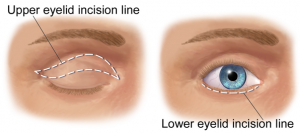Blepharoplasty
The eyes are one of the most important parts of one’s appearance. With age, eyelid skin can loosen and sag. This redundant skin can give the lids a hooded appearance and interfere with the superior visual field. From an aesthetic standpoint, this loose skin can make one look older or more tired than they are. It can also interfere with wearing makeup. Excess, puffy, lax skin is caused by age, eyelid rubbing, sun exposure, hereditary factors, and allergy.

Upper Eyelid Surgery
Hanging eyelid skin, also called pseudo ptosis, or dermatochalasis, can be removed with surgery. This procedure, called a blepharoplasty, or eye- lift, is done as an outpatient procedure under twilight anesthesia. The excess skin and fat is removed as needed. Incisions are placed in the natural crease of the eyelid. These incisions are well hidden and barely visible after a few months.
Old photographs are often helpful to create a surgical plan and goal for the final “look of the eyes.”
Is Blepharoplasty Covered by Health Insurance?
If there is enough skin to obstruct vision, an upper eyelid blepharoplasty may be covered by your insurance plan. Depending on your insurance, special tests are needed to prove medical necessity. These can be performed in our office.
Lower Eyelid Blepharoplasty
Lower eyelids can also appear saggy and puffy. Patients often complain about tired looking eyes, dark circles, and lower lid bags. These changes are also a result of age, sun exposure, heredity, and loosening of the lower lid tendons. Surgery, a lower lid blepharoplasty, can improve these issues. Like in the upper eyelids, excess skin and fat are removed as needed. In addition, fat can also be repositioned to fill in some of the deep grooves caused by aging. Incisions are placed just under the lower eyelashes and in the crows feet area. These blend in well and are barely visible after a few months.
Lower eyelid blepharoplasty is also an outpatient procedure that can be done at the same time as the upper lids. The lower lids, however, rarely interfere with vision. Therefore, lower lid blepharoplasty is usually considered cosmetic and not covered by insurance.
Recovery from Eyelid Blepharoplasty
Following surgery on all four eyelids, patients can expect to be swollen and black and blue for a week or so. The exact duration depends on each individual patient. We recommend using frozen peas and vegetables on the eyelids as much as possible for the first 48 hours after surgery. This decreases swelling, bruising, and discomfort. Cool compresses are also helpful several times a day during the first week after surgery.





